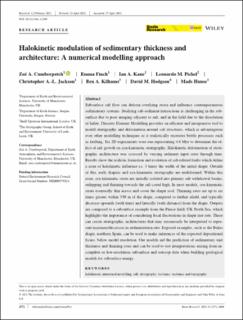| dc.contributor.author | Cumberpatch, Zoë A. | |
| dc.contributor.author | Finch, Emma | |
| dc.contributor.author | Kane, Ian A. | |
| dc.contributor.author | Pichel, Leonardo Muniz | |
| dc.contributor.author | Jackson, Christopher A.-L. | |
| dc.contributor.author | Kilhams, Ben | |
| dc.contributor.author | Hodgson, David M. | |
| dc.contributor.author | Huuse, Mads | |
| dc.date.accessioned | 2022-03-29T11:09:42Z | |
| dc.date.available | 2022-03-29T11:09:42Z | |
| dc.date.created | 2022-01-28T08:26:14Z | |
| dc.date.issued | 2021 | |
| dc.identifier.issn | 0950-091X | |
| dc.identifier.uri | https://hdl.handle.net/11250/2988310 | |
| dc.description.abstract | Subsurface salt flow can deform overlying strata and influence contemporaneous sedimentary systems. Studying salt-sediment interactions is challenging in the subsurface due to poor imaging adjacent to salt, and in the field due to the dissolution of halite. Discrete Element Modelling provides an efficient and inexpensive tool to model stratigraphy and deformation around salt structures, which is advantageous over other modelling techniques as it realistically recreates brittle processes such as faulting. Six 2D experiments were run representing 4.6 Myr to determine the effect of salt growth on syn-kinematic stratigraphy. Halokinetic deformation of stratigraphic architecture was assessed by varying sediment input rates through time. Results show the realistic formation and evolution of salt-related faults which define a zone of halokinetic influence ca. 3 times the width of the initial diapir. Outside of this, early diapiric and syn-kinematic stratigraphy are undeformed. Within this zone, syn-kinematic strata are initially isolated into primary salt withdrawal basins, onlapping and thinning towards the salt-cored high. In most models, syn-kinematic strata eventually thin across and cover the diapir roof. Thinning rates are up to six times greater within 350 m of the diapir, compared to further afield, and typically decrease upwards (with time) and laterally (with distance) from the diapir. Outputs are compared to a subsurface example from the Pierce field, UK North Sea, which highlights the importance of considering local fluctuations in diapir rise rate. These can create stratigraphic architectures that may erroneously be interpreted to represent increases/decreases in sedimentation rate. Exposed examples, such as the Bakio diapir, northern Spain, can be used to make inferences of the expected depositional facies, below model resolution. Our models aid the prediction of sedimentary unit thickness and thinning rates and can be used to test interpretations arising from incomplete or low-resolution subsurface and outcrop data when building geological models for subsurface energy. | en_US |
| dc.language.iso | eng | en_US |
| dc.publisher | Wiley | en_US |
| dc.rights | Navngivelse 4.0 Internasjonal | * |
| dc.rights.uri | http://creativecommons.org/licenses/by/4.0/deed.no | * |
| dc.title | Halokinetic modulation of sedimentary thickness and architecture: A numerical modelling approach | en_US |
| dc.type | Journal article | en_US |
| dc.type | Peer reviewed | en_US |
| dc.description.version | publishedVersion | en_US |
| dc.rights.holder | Copyright 2021 The Authors | en_US |
| cristin.ispublished | true | |
| cristin.fulltext | original | |
| cristin.qualitycode | 2 | |
| dc.identifier.doi | 10.1111/bre.12569 | |
| dc.identifier.cristin | 1991944 | |
| dc.source.journal | Basin Research | en_US |
| dc.source.pagenumber | 2572-2604 | en_US |
| dc.identifier.citation | Basin Research. 2021, 33 (5), 2572-2604. | en_US |
| dc.source.volume | 33 | en_US |
| dc.source.issue | 5 | en_US |

